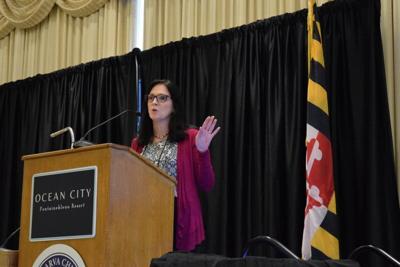OCEAN CITY, Md. — The avian influenza strain killing poultry across the United States is more infectious than the one that hit over 200 flocks in the last major outbreak.
The virus dose needed to cause infection is much lower than in 2015, said Mary Pantin-Jackwood, a veterinary researcher at USDA's Southeast Poultry Research Laboratory in Georgia.
Pantin-Jackwood spoke Oct. 4 at the National Meeting on Poultry Health, Processing and Live Production presented by the Delmarva Chicken Association.
Avian influenza viruses circulate in wild waterfowl. In most cases, including the 2015 Midwest outbreak that cost the U.S. 50 million birds, the virus transfers from wild birds to poultry in a low pathogenic form, and then may adapt to become more infectious and deadly in domestic birds.
These outbreaks are usually controlled quickly. Once the infected flocks are killed and the farms are cleaned up, “those particular viruses are gone,” Pantin-Jackwood said.
This year’s H5N1 strain is starting out in wild birds as infectious as the disease that spread among poultry farms in 2015. The disease has infected 231 commercial farms and caused nearly 47 million birds to be depopulated.
An early sign that the current strain would be different was its activity in the wild; the virus is killing some species of waterfowl, which don’t generally show clinical signs of avian influenza. Other waterfowl species withstand the disease but spread it.
In 2015, only 98 wild birds were identified as infected, compared to 2,600 across 85 species this year. The birds that died of disease include hawks and large groups of vultures — birds that feed on waterfowl.
This year’s strain has also infected carrion-feeding mammals like foxes, opossums and raccoons. No mammals were infected in 2015, Pantin-Jackwood said.
The current strain has also traveled more widely than its 2015 counterpart. The active strain made it to the waterfowl migration routes along the East Coast, which was spared seven years ago.
Still, virus dose, bird age and bird species can affect a flock’s susceptibility.
Compared to chickens, turkeys are more likely to become infected by a low dose of the virus and to transmit the disease. Turkeys also take longer to die, Pantin-Jackwood said.
The domestic species related to chickens, like quails and guineas, require a low dose to become infected. These types of birds are common in backyard flocks, which have seen 10 times as many outbreaks this year than in 2015.
“If they meet a duck that’s infected, they will become infected. And then it’s a way how the virus could eventually also infect other birds,” Pantin-Jackwood said.
Elevated deaths are the best indicator of an avian influenza outbreak, but decreases in feed, water and egg production can also be red flags. Diagnosis in farmed ducks is particularly hard because they show few clinical signs, Pantin-Jackwood said.
Reading the Virus’ History
If today’s avian influenza virus is especially aggressive, USDA is also better equipped to understand it than it was in 2015.
That year, USDA’s national veterinary lab in Iowa sequenced full genomes for only 260 samples, which can show where the virus came from. This year, thanks to expanded testing capability, it’s approaching 4,000.
By comparing the genomes from multiple sites, researchers can make a good guess about where the disease came from and how it got into a farm.
For example, samples from a Newfoundland farm, one of the first North American sites affected in this outbreak, showed that the virus resembled a strain that was causing problems in Europe.
Another sample in Alaska showed that virus was similar to one circulating in Japan. USDA has identified three incursions of the virus, two from Europe and one from the Pacific.
“That immediately tells us, oh, now we know who we’re dealing with,” Pantin-Jackwood said.
The most prevalent strain reassorted its genes when it interacted with existing North American avian influenza viruses, and it spread quickly across the country.
Similar genomes can also suggest farm-to-farm transmission, which was a major problem in 2015. This year almost all of the outbreaks appear to be separate introductions linked to wild birds.
“You’re doing a good job on the farm-to-farm, but we still are not stopping the virus from infecting premises,” Pantin-Jackwood said.
That’s a problem because waterfowl are continuing to shed the H5N1 virus. Farms must continue to focus on biosecurity, she said.
It’s not clear if the current avian influenza strain will establish itself for the long term as one of the viruses circulating in the U.S. If enough birds became affected, it’s possible that flocks could develop a level of herd immunity, but there will always be young birds for the disease to infect, Pantin-Jackwood said.

